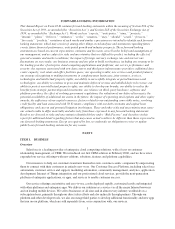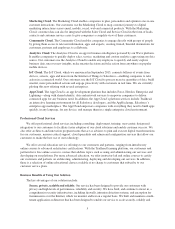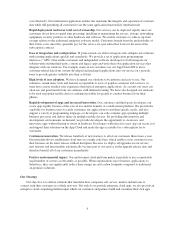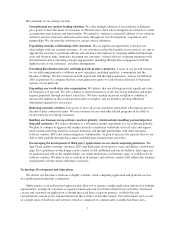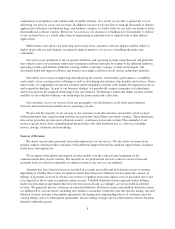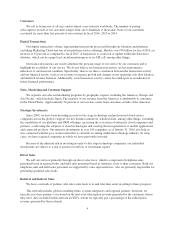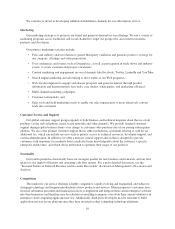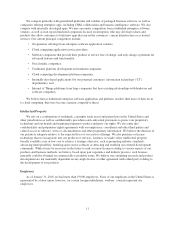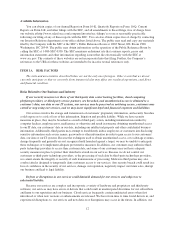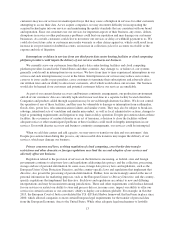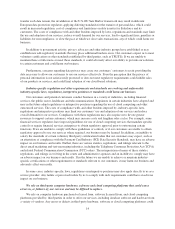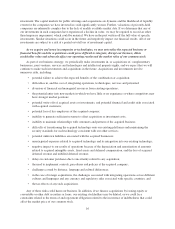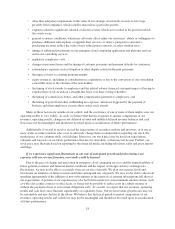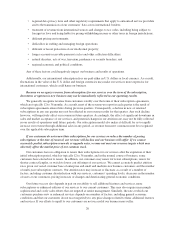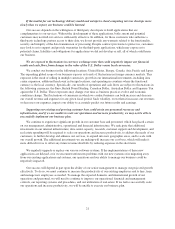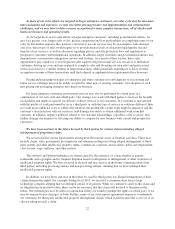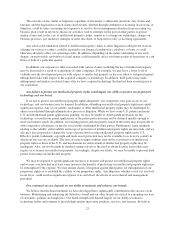Salesforce.com 2016 Annual Report Download - page 20
Download and view the complete annual report
Please find page 20 of the 2016 Salesforce.com annual report below. You can navigate through the pages in the report by either clicking on the pages listed below, or by using the keyword search tool below to find specific information within the annual report.customers may use our services in unanticipated ways that may cause a disruption in services for other customers
attempting to access their data. As we acquire companies, we may encounter difficulty in incorporating the
acquired technologies into our services and maintaining the quality standards that are consistent with our brand
and reputation. Since our customers use our services for important aspects of their business, any errors, defects,
disruptions in service or other performance problems could hurt our reputation and may damage our customers’
businesses. As a result, customers could elect to not renew our services or delay or withhold payment to us. We
could also lose future sales or customers may make warranty or other claims against us, which could result in an
increase in our provision for doubtful accounts, an increase in collection cycles for accounts receivable or the
expense and risk of litigation.
Interruptions or delays in services from our third-party data center hosting facilities or cloud computing
platform providers could impair the delivery of our services and harm our business.
We currently serve our customers from third-party data center hosting facilities and cloud computing
platform providers located in the United States and other countries. Any damage to, or failure of, our systems
generally could result in interruptions in our services. We have from time to time experienced interruptions in our
services and such interruptions may occur in the future. Interruptions in our services may reduce our revenue,
cause us to issue credits or pay penalties, cause customers to terminate their subscriptions and adversely affect
our attrition rates and our ability to attract new customers, all of which would reduce our revenue. Our business
would also be harmed if our customers and potential customers believe our services are unreliable.
As part of our current disaster recovery and business continuity arrangements, our production environment
and all of our customers’ data are currently replicated in near real-time in a separate facility located elsewhere.
Companies and products added through acquisition may be served through alternate facilities. We do not control
the operation of any of these facilities, and they may be vulnerable to damage or interruption from earthquakes,
floods, fires, power loss, telecommunications failures and similar events. They may also be subject to break-ins,
sabotage, intentional acts of vandalism and similar misconduct, as well as local administrative actions, changes to
legal or permitting requirements and litigation to stop, limit or delay operation. Despite precautions taken at these
facilities, the occurrence of a natural disaster or an act of terrorism, a decision to close the facilities without
adequate notice or other unanticipated problems at these facilities could result in lengthy interruptions in our
services. Even with disaster recovery and business continuity arrangements, our services could be interrupted.
When we add data centers and add capacity, we may move or transfer our data and our customers’ data.
Despite precautions taken during this process, any unsuccessful data transfers may impair the delivery of our
services, which may damage our business.
Privacy concerns and laws, evolving regulation of cloud computing, cross-border data transfer
restrictions and other domestic or foreign regulations may limit the use and adoption of our services and
adversely affect our business.
Regulation related to the provision of services on the Internet is increasing, as federal, state and foreign
governments continue to adopt new laws and regulations addressing data privacy and the collection, processing,
storage and use of personal information. In some cases, foreign data privacy laws and regulations, such as the
European Union’s Data Protection Directive, and the country-specific laws and regulations that implement that
directive, also govern the processing of personal information. Further, laws are increasingly aimed at the use of
personal information for marketing purposes, such as the European Union’s e-Privacy Directive, and the country-
specific regulations that implement that directive. Such laws and regulations are subject to new and differing
interpretations and may be inconsistent among jurisdictions. These and other requirements could reduce demand
for our services or restrict our ability to store and process data or, in some cases, impact our ability to offer our
services in certain locations or our customers’ ability to deploy our solutions globally. For example, in October
2015, the European Court of Justice invalidated the U.S.-EU Safe Harbor framework that had been in place since
2000, which allowed companies to meet certain European legal requirements for the transfer of personal data
from the European Economic Area to the United States. While other adequate legal mechanisms to lawfully
13


